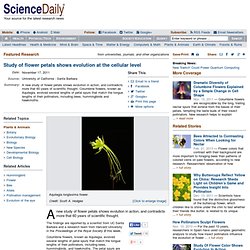

The Big Bloom - How Flowering Plants changed the World. In the summer of 1973 sunflowers appeared in my father's vegetable garden.

They seemed to sprout overnight in a few rows he had lent that year to new neighbors from California. Only six years old at the time, I was at first put off by these garish plants. Such strange and vibrant flowers seemed out of place among the respectable beans, peppers, spinach, and other vegetables we had always grown. Gradually, however, the brilliance of the sunflowers won me over. Their fiery halos relieved the green monotone that by late summer ruled the garden. Flowers have a way of doing that. Today flowering plant species outnumber by twenty to one those of ferns and cone-bearing trees, or conifers, which had thrived for 200 million years before the first bloom appeared. Timeline of plant evolution. This article attempts to place key plant innovations in a geological context.

It concerns itself only with novel adaptations and events that had a major ecological significance, not those that are of solely anthropological interest. Evolutionary history of plants. A late Siluriansporangium.

Green: A spore tetrad. Blue: A spore bearing a trilete mark – the -shaped scar. Trapped in Amber, the Oldest Evidence of Pollination. Mutation over 100 million years ago led flowers to make male and female parts differently. Research by University of Leeds plant scientists has uncovered a snapshot of evolution in progress, by tracing how a gene mutation over 100 million years ago led flowers to make male and female parts in different ways.

Evolutionary History of Cypress Tree Reflects the Breakup of Pangaea. New research from biologists at Ludwig Maximilian University of Munich examines the evolutionary history of the cypress tree, finding that their origins can be traced back to the break-up of Pangea about 153 million years ago.

In classical mythology, the cypress tree is associated with death, the underworld and eternity. Indeed, the family to which cypresses belong, is an ancient lineage of conifers, and a new study of their evolution affords a unique insight into a turbulent era in the Earth’s history. During the geological era known as the Mesozoic, the continental crust was concentrated in a single huge landmass, the supercontinent Pangea. Pangea began to break up about 150 million years ago, and the fragments drifted apart, eventually giving rise to the disposition of continents we know today. Study of flower petals shows evolution at the cellular level.
A new study of flower petals shows evolution in action, and contradicts more that 60 years of scientific thought.

The findings are reported by a scientist from UC Santa Barbara and a research team from Harvard University in the Proceedings of the Royal Society B this week. Columbine flowers, known as Aquilegia, evolved several lengths of petal spurs that match the tongue lengths of their pollinators, including bees, hummingbirds, and hawkmoths. The petal spurs are shaped like a tubular pocket and contain nectar at the tip. The spurs grow from 1 to 16 centimeters in length, depending on the species. The research team discovered that longer spurs result from the lengthening of cells in one direction, called anisotropy, and not from an increased number of cells. "When we went in and looked at this in detail, we found that even the super-long-spurred flower doesn't differ much in cell number from the short-spurred one," said Scott A.
In addition to Hodges, the co-authors are Joshua R. Evolution experiments with flowers. Evolution uses every chance it gets to try something new.

Dutch researcher Anneke Rijpkema investigated how petunia flowers are formed and discovered that nature is even more varied than the naked eye can spot. The genes involved in flower formation can function differently in different species. Evolution has discovered a system that works, but within that system it continues to innovate. Up until now, research into the regulation of flower formation focused mostly on two model species: Arabidopsis and Anthirrhinum. Yet according to Rijpkema that is not enough to gain a complete picture. Rijpkema analysed which genes are responsible for the flower formation in petunia. Petunias, tomatoes and gerberas Besides unveiling how evolution works in plants, Rijpkema's research also reveals how plants function now. Rijpkema carried out her research at Radboud University Nijmegen with a grant from NWO. How Plants Learned To Respond To Changing Environments. A team of John Innes centre scientists lead by Professor Nick Harberd have discovered how plants evolved the ability to adapt to changes in climate and environment.

Plants adapt their growth, including key steps in their life cycle such as germination and flowering, to take advantage of environmental conditions. They can also repress growth when their environment is not favourable. This involves many complex signalling pathways which are integrated by the plant growth hormone gibberellin. Weeds That Reinvented Weediness: New Research Sheds Light On Origins And Success Of Flowering Plants. Flowering plants are all around us and are phenomenally successful.

But how did they get to be so successful and where did they come from? This question bothered Darwin and others, and now a paper published in the September issue of the Botanical Journal of the Linnean Society indicates that their ability to adapt anatomically may be the answer. Sherwin Carlquist, a research botanist at the Santa Barbara Botanic Garden and recipient of the Linnean Medal for Botany, has spent his career studying “non-tree” s flowering plants to discover more about their origins and the reason behind their success.
“Fossil evidence had provided some answers and DNA evidence had shown us how earlier flowering plants were related, but how they looked, and what their wood was like, were neglected topics,” says Dr Carlquist. “Flowering plants are the new weeds, able to keep reinventing new forms and wood patterns. How did flowering plants evolve to dominate Earth? To Charles Darwin it was an 'abominable mystery' and it is a question which has continued to vex evolutionists to this day: when did flowering plants evolve and how did they come to dominate plant life on earth?

A new study in Ecology Letters reveals the evolutionary trigger which led to early flowering plants gaining a major competitive advantage over rival species, leading to their subsequent boom and abundance. The study, by Dr Tim Brodribb and Dr Taylor Field of the University of Tasmania and University of Tennessee, used plant physiology to reveal how flowering plants, including crops, were able to dominate land by evolving more efficient hydraulics, or 'leaf plumbing', to increase rates of photosynthesis. "Flowering plants are the most abundant and ecologically successful group of plants on earth," said Brodribb. "Without this hydraulic system we predict leaf photosynthesis would be two-fold lower then present," concludes Brodribb. Darwin’s Mystery Of Appearance Of Flowering Plants Explained. The appearance of many species of flowering plants on Earth, and especially their relatively rapid dissemination during the Cretaceous (approximately 100 million years ago) can be attributed to their capacity to transform the world to their own needs.
In an article in Ecology Letters, Wageningen ecologists Frank Berendse and Marten Scheffer postulate that flowering plants changed the conditions during the Cretaceous period to suit themselves. The researchers have consequently provided an entirely new explanation for what Charles Darwin considered to be one of the greatest mysteries with which he was confronted. During the Cretaceous, the Earth's surface underwent one of its greatest changes in vegetation composition, a change which also took place with unprecedented speed. Frank Berendse (Professor of Nature Conservation and Plant Ecology), and Marten Scheffer, (Professor of Aquatic Ecology), both at Wageningen University, wanted to understand how this happened. Flowering Plants Evolved Very Quickly Into Five Groups.
University of Florida and University of Texas at Austin scientists have shed light on what Charles Darwin called the "abominable mystery" of early plant evolution. The scientists are reporting that the two largest groups of flowering plants are more closely related to each other than any of the other major lineages. These are the monocots, which include grasses and their relatives, and the eudicots, which include sunflowers and tomatoes. Doug and Pam Soltis, a UF professor of botany and curator at UF's Florida Museum of Natural History, respectively, also showed that a stunning diversification of flowering plants they are referring to as the "Big Bang" took place in the comparatively short period of less than 5 million years -- and resulted in all five major lineages of flowering plants that exist today.
"Flowering plants today comprise around 400,000 species," said Pam Soltis. As for the diversification's cause, it remains mysterious, Pam and Doug Soltis said.